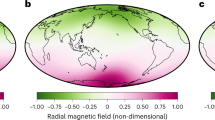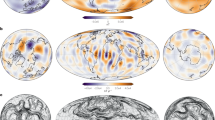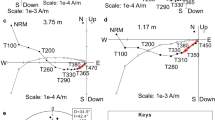Abstract
THERE is a strong (0.93) correlation1,2 between the change in the length of day and the change in westward velocity of the eccentric dipole or “magnetic centre” (as defined by Schmidt3) of the geomagnetic field, presumably because of the conservation of the angular momentum of the Earth. If the motion of the eccentric dipole is related to a motion somewhere in the core in which the magnetic field is “frozen” into the fluid, then a change in westward motion and angular momentum in the core must be compensated for by a change in angular momentum of the mantle. This appears as a change in the length of day, as determined astronomically.
This is a preview of subscription content, access via your institution
Access options
Subscribe to this journal
Receive 51 print issues and online access
$199.00 per year
only $3.90 per issue
Buy this article
- Purchase on SpringerLink
- Instant access to full article PDF
Prices may be subject to local taxes which are calculated during checkout
Similar content being viewed by others
References
Vestine, E. H., and Kahle, Anne B., Geophys. J. Roy. Astro. Soc., 15, 29 (1968).
Ball, R. H., Kahle, Anne B., and Vestine, E. H., RM-5717-PR, The Rand Corporation, Santa Monica, California, USA (October 1968).
Chapman, S., and Bartels, J., Geomagnetism, 648 (Oxford University Press, London, 1940).
Vestine, E. H., Proc. US Nat. Acad. Sci., 38, 1030 (1952).
Cain, J. C., Hendricks, S. J., Langel, R. A., and Hudson, W. V., J. Geomag. Geoelec., 19, 335 (1967).
US Naval Observatory, The American Ephemeris and Nautical Almanac for the Year 1968.
Cain, J. C., and Cain, S. J., NASA X-612-68-501, Goddard Space Flight Center, Greenbelt, Maryland, USA (December 1968).
Author information
Authors and Affiliations
Rights and permissions
About this article
Cite this article
KAHLE, A., BALL, R. & CAIN, J. Prediction of Geomagnetic Secular Change confirmed. Nature 223, 165 (1969). https://doi.org/10.1038/223165a0
Received:
Issue date:
DOI: https://doi.org/10.1038/223165a0



